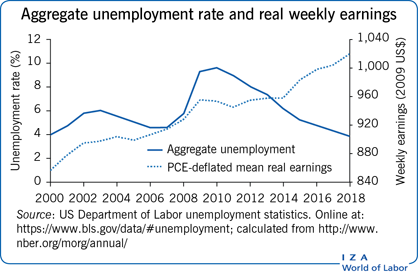Elevator pitch
As the largest economy in the world, the US labor market is crucial to the economic well-being of citizens worldwide as well, of course, that of its own citizens. Since 2000 the US labor market has undergone substantial changes, both reflecting the Great Recession, but also resulting from some striking trends. Most interesting have been a remarkable drop in the labor force participation rate, reversing a nearly 50-year trend; the full recovery of unemployment from the depths of the Great Recession; and the little-known continuing growth in post-inflation average earnings.

Key findings
Pros
Unemployment has gone below its pre-Great Recession level.
The job vacancy rate is at its highest since data have been collected and now exceeds the hire rate.
The labor force participation of men and women aged 20–54 has fallen, so that in 2018 the labor force has six million fewer people than were expected in 2000.
Real earnings of the average and median-earning full-time worker have risen.
Women’s wages have risen relative to those of men but remain somewhat below men’s.
Cons
Even at full employment in 2018, long-term unemployment is much greater than at similar points of the business cycle in the past.
Youth unemployment remains far above the adult average.
The labor force participation of men and women aged 20–54 has fallen, so that in 2018 the labor force has six million fewer people than were expected in 2000.
Wage inequality has continued to increase, with this rise concentrated in the upper half of the earnings distribution.
Wages of African-American workers have fallen compared to those of white workers and remain far below those of white Americans.